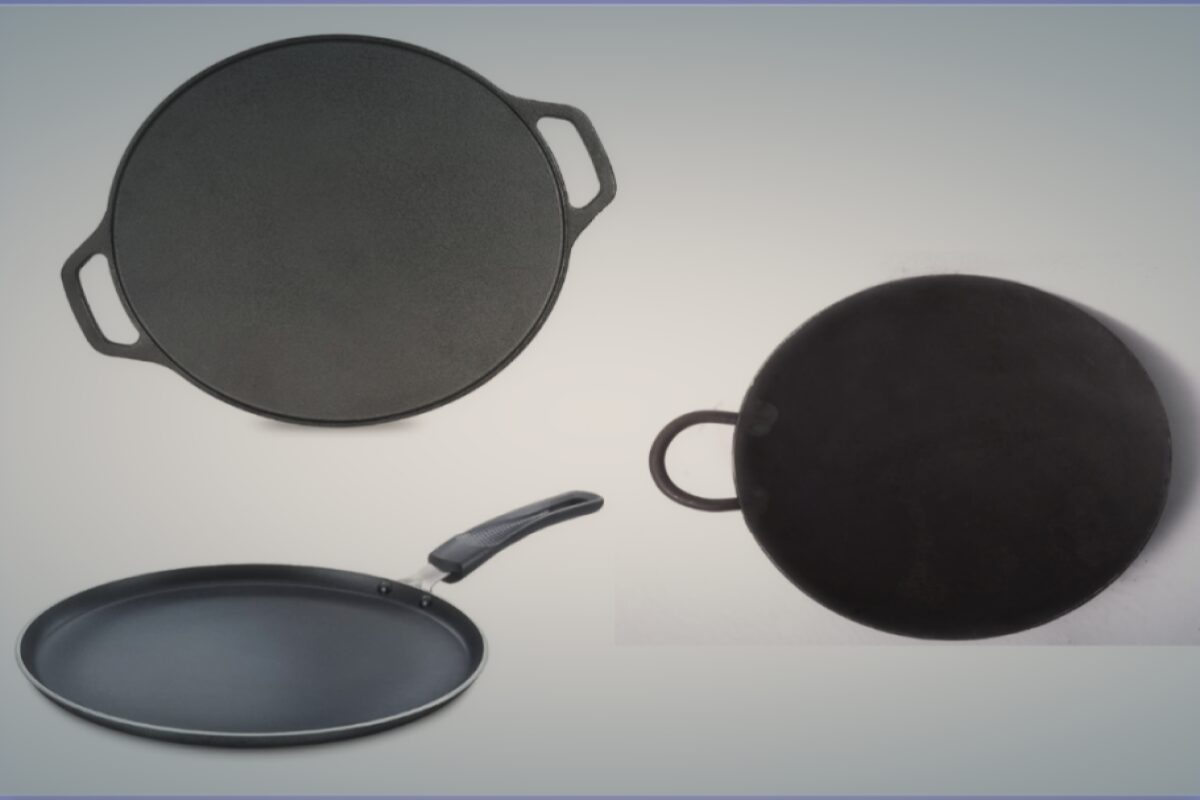Key factors to consider when buying a dosa tawa
There is a wide range of tawas available in the market, crafted from various materials and featuring different shapes. Selecting the right tawa is indeed crucial for achieving the perfect dosa. Here are some key factors to consider when choosing a dosa tawa:
Material
Tawas are commonly made from various materials such as cast iron, iron, and non-stick coatings. Each material has its advantages and disadvantages
- Cast iron: A cast iron tawa, essentially a heavy, flat pan made from cast iron, retains heat well and distributes it evenly across the cooking surface. These tawas provide a natural non-stick surface once seasoned, making them ideal for making crispy dosas. Cast iron is incredibly durable and can last for generations if properly cared for. It withstands high heat and resists warping or bending. Cooking with cast iron can add small amounts of iron to your food, beneficial for individuals who are iron deficient.
- Iron Tawas: Iron tawas, made from iron, are highly durable and resistant to warping and scratching, ensuring reliable long-term use. They exhibit exceptional heat retention properties and evenly distribute heat across the cooking surface. When seasoned properly, iron tawas develop a natural non-stick coating over time.
- Non-Stick Tawas: These tawas feature a non-stick coating that prevents food from sticking to the surface, requiring less oil or butter. They are generally easier to clean and provide good heat conductivity, ensuring even heat distribution across the cooking surface. Traditional non-stick coatings, made using a compound called polytetrafluoroethylene (PTFE), release harmful fumes, including toxic gases, at high temperatures, posing serious health risks.
Cast iron and iron tawas provide a natural non-stick surface and pose no health hazards. On the other hand, non-stick tawas are made using chemical coatings which are not safe.
Shape and Size
The shape of the tawa plays a significant role in dosa-making. The two types of tawa are the:
- Concave Tawa: A concave tawa has a slight depression or indentation in the center. The concave shape helps prevents the oil from spilling to the sides, while facilitating even cooking.
- Flat Tawa: A flat tawa has a completely level surface without any indentation or depression in the center. While the batter can be spread evenly oil tends to flow towards the edges rather than pooling to the dosa.
Thickness
A thick and heavy-bottomed tawa ensures even heat distribution and prevents hot spots, which can lead to unevenly cooked dosas. It also helps in retaining heat, crucial for achieving crispy dosas.
A thick, heavy-bottomed, concave tawa is a preferred method for making crispy dosas, as it provides the ideal conditions for achieving the desired texture and flavor.

Cast Iron Tawa vs Iron Tawa
Both types of tawas are made of iron, but cast iron tawas are made using a casting process, which involves pouring molten iron into a mold. Traditional iron tawas are usually forged or hammered into shape from a solid piece of iron.
Cast iron tends to be thicker and heavier compared to traditional iron tawas.
Cast iron has a seamless body meaning it has no joints for handles. The handles are often an integral part of the design, cast along with the main body of the cookware rather than being attached separately. This seamless construction is one of the distinguishing features of cast iron cookware and contributes to its durability and strength
Between iron and cast iron tawas, cast iron typically heats more slowly but retains heat better once it reaches the desired temperature. Iron tawa on the other hands heats quickly but lose heat faster compared to cast iron tawas. This difference in heat retention can affect cooking times and results.
Conclusion
A thick and heavy-bottomed tawa heats up more slowly but retains heat well once heated. A thick, heavy-bottomed tawa helps prevent the dosa from heating too quickly, which can lead to uneven
The concave shape of the tawa helps prevent oil or ghee from spilling over the edges, which can be common when making dosas on flat tawas.
Overall, choosing a thick, heavy-bottomed, concave tawa is a preferred method for making crispy dosas, as it provides the ideal conditions for achieving the desired texture and flavor.
While both types of tawas can be used for making dosas, many traditional dosa recipes recommend using a concave tawa for the best results. Ultimately, the choice between a concave and flat tawa for dosa-making depends on personal preference, availability, and cooking habits.

